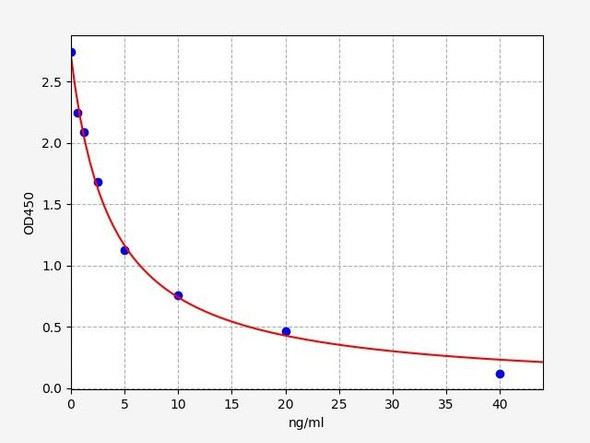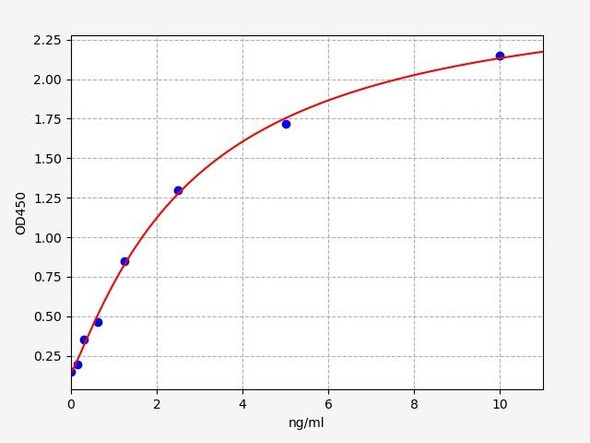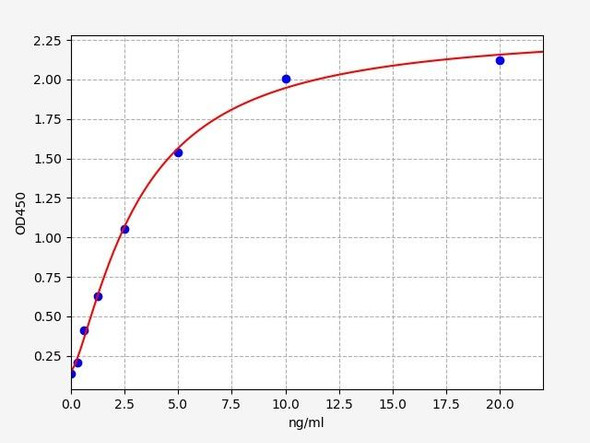Human E3 ubiquitin-protein ligase AMFR (AMFR) ELISA Kit (HUEB1631)
- SKU:
- HUEB1631
- Product Type:
- ELISA Kit
- Size:
- 96 Assays
- Uniprot:
- Q9UKV5
- ELISA Type:
- Sandwich
- Synonyms:
- AMFR, E3 ubiquitin-protein ligase AMFR, gp78, Autocrine motility factor receptor, AMF receptor, RING finger protein 45, GP78, RNF45
- Reactivity:
- Human
Description
Human E3 ubiquitin-protein ligase AMFR (AMFR) ELISA Kit
The Human E3 Ubiquitin Protein Ligase AMFR (AMFR) ELISA Kit is specially designed for the precise quantification of AMFR levels in human biological samples such as serum, plasma, and cell culture supernatants. This kit offers high sensitivity and specificity, ensuring accurate and reproducible results for a variety of research applications.AMFR is an essential protein involved in the ubiquitination process, regulating protein degradation and turnover within cells. Dysregulation of AMFR has been linked to various diseases, including cancer, neurodegenerative disorders, and autoimmune conditions.
Therefore, measuring AMFR levels can provide valuable insights into disease progression and potential therapeutic strategies.With easy-to-follow protocols and superior performance, the Human E3 Ubiquitin Protein Ligase AMFR (AMFR) ELISA Kit is a reliable tool for research studies focused on understanding the molecular mechanisms underlying disease pathogenesis and exploring novel treatment approaches. Order yours today to accelerate your research efforts.
| Product Name: | Human E3 ubiquitin-protein ligase AMFR (AMFR) ELISA Kit |
| SKU: | HUEB1631 |
| Size: | 96T |
| Target: | Human E3 ubiquitin-protein ligase AMFR (AMFR) |
| Synonyms: | Autocrine motility factor receptor, RING finger protein 45, RING-type E3 ubiquitin transferase AMFR, gp78, AMF receptor, RNF45 |
| Assay Type: | Sandwich |
| Detection Method: | ELISA |
| Reactivity: | Human |
| Detection Range: | 0.625-40ng/mL |
| Sensitivity: | 0.34ng/ml |
| Intra CV: | 4.9% | ||||||||||||||||||||
| Inter CV: | 7.4% | ||||||||||||||||||||
| Linearity: |
| ||||||||||||||||||||
| Recovery: |
| ||||||||||||||||||||
| Function: | E3 ubiquitin-protein ligase that mediates the polyubiquitination of a number of proteins such as CD3D, CYP3A4, CFTR and APOB for proteasomal degradation. Component of a VCP/p97-AMFR/gp78 complex that participates in the final step of endoplasmic reticulum-associated degradation (ERAD). The VCP/p97-AMFR/gp78 complex is involved in the sterol-accelerated ERAD degradation of HMGCR through binding to the HMGCR-INSIG complex at the ER membrane and initiating ubiquitination of HMGCR. The ubiquitinated HMGCR is then released from the ER by the complex into the cytosol for subsequent destruction. Also regulates ERAD through the ubiquitination of UBL4A a component of the BAG6/BAT3 complex. Also acts as a scaffold protein to assemble a complex that couples ubiquitination, retranslocation and deglycosylation. Mediates tumor invasion and metastasis as a receptor for the GPI/autocrine motility factor. |
| Uniprot: | Q9UKV5 |
| Sample Type: | Serum, plasma, tissue homogenates, cell culture supernates and other biological fluids |
| Specificity: | Natural and recombinant human E3 ubiquitin-protein ligase AMFR |
| Sub Unit: | Interacts with RNF5. Also forms an ERAD complex containing VCP/p97, NGLY1; PSMC1; SAKS1 AND RAD23B required for coupling retrotranslocation, ubiquitination and deglycosylation (By similarity). Interacts with DRL1. Interacts (through a region distinct from the RING finger) with UBE2G2/UBC7. Component of the VCP/p97-AMFR/gp78 complex that enhances VCP/p97 binding to polyubiquitinated proteins for their degradation by the endoplasmic reticulum-associated degradation (ERAD) pathway. Interacts (via the VIM) with VCP/p97. Interacts (via its membrane domain) with INSIG1; the interaction initiates the sterol-mediated ubiquitination and degradation of HMGCR by the ERAD pathway. Interacts with BAG6 (PubMed:21636303). Interacts with USP13 (via UBA 2 domain); the interaction is direct (PubMed:24424410). |
| Research Area: | Cancer |
| Subcellular Location: | Endoplasmic reticulum membrane Multi-pass membrane protein |
| Storage: | Please see kit components below for exact storage details |
| Note: | For research use only |
| UniProt Protein Function: | AMFR: E3 ubiquitin-protein ligase that mediates the polyubiquitination of a number of proteins such as CD3D, CYP3A4, CFTR and APOB for proteasomal degradation. Component of a VCP/p97- AMFR/gp78 complex that participates in the final step of endoplasmic reticulum-associated degradation (ERAD). The VCP/p97- AMFR/gp78 complex is involved in the sterol-accelerated ERAD degradation of HMGCR through binding to the HMGCR-INSIG complex at the ER membrane and initiating ubiquitination of HMGCR. The ubiquitinated HMGCR is then released from the ER by the complex into the cytosol for subsequent destruction. Also acts as a scaffold protein to assemble a complex that couples ubiquitination, retranslocation and deglycosylation. Mediates tumor invasion and metastasis. Interacts with RNF5. Also forms an ERAD complex containing VCP/p97, NGLY1; PSMC1; SAKS1 AND RAD23B required for coupling retrotranslocation, ubiquitination and deglycosylation. Interacts with DRL1. Interacts (through a region distinct from the RING finger) with UBE2G2/UBC7. Component of the VCP/p97-AMFR/gp78 complex that enhances VCP/p97 binding to polyubiquitinated proteins for their degradation by the endoplasmic reticulum-associated degradation (ERAD) pathway. Interacts (via the VIM) with VCP/p97. Interacts (via its membrane domain) with INSIG1; the interaction initiates the sterol-mediated ubiquitination and degradation of HMGCR by the ERAD pathway. 2 isoforms of the human protein are produced by alternative splicing. |
| UniProt Protein Details: | Protein type:Ubiquitin ligase; Ligase; Membrane protein, integral; EC 6.3.2.19; Endoplasmic reticulum; Ubiquitin conjugating system; Motility/polarity/chemotaxis; EC 6.3.2.-; Membrane protein, multi-pass; Receptor, misc. Chromosomal Location of Human Ortholog: 16q21 Cellular Component: endoplasmic reticulum membrane; growth cone; protein complex; cell soma; membrane; perinuclear region of cytoplasm; dendrite; integral to membrane; integral to endoplasmic reticulum membrane; nucleus Molecular Function:protein binding; zinc ion binding; ubiquitin-protein ligase activity; receptor activity; ligase activity Biological Process: ubiquitin-dependent protein catabolic process; ER-associated protein catabolic process; protein polyubiquitination; learning and/or memory; unfolded protein response; cell motility; signal transduction; protein oligomerization; aging |
| NCBI Summary: | This locus encodes a glycosylated transmembrane receptor. Its ligand, autocrine motility factor, is a tumor motility-stimulating protein secreted by tumor cells. The encoded receptor is also a member of the E3 ubiquitin ligase family of proteins. It catalyzes ubiquitination and endoplasmic reticulum-associated degradation of specific proteins. [provided by RefSeq, Feb 2012] |
| UniProt Code: | Q9UKV5 |
| NCBI GenInfo Identifier: | 113707 |
| NCBI Gene ID: | 267 |
| NCBI Accession: | P26442.1 |
| UniProt Secondary Accession: | Q9UKV5,P26442, Q8IZ70, |
| UniProt Related Accession: | Q9UKV5 |
| Molecular Weight: | 323 |
| NCBI Full Name: | |
| NCBI Synonym Full Names: | autocrine motility factor receptor |
| NCBI Official Symbol: | AMFR |
| NCBI Official Synonym Symbols: | GP78; RNF45 |
| NCBI Protein Information: | E3 ubiquitin-protein ligase AMFR |
| UniProt Protein Name: | E3 ubiquitin-protein ligase AMFR |
| UniProt Synonym Protein Names: | Autocrine motility factor receptor; AMF receptor; RING finger protein 45; gp78 |
| Protein Family: | E3 ubiquitin-protein ligase |
| UniProt Gene Name: | AMFR |
| UniProt Entry Name: | AMFR_HUMAN |
| Component | Quantity (96 Assays) | Storage |
| ELISA Microplate (Dismountable) | 8×12 strips | -20°C |
| Lyophilized Standard | 2 | -20°C |
| Sample Diluent | 20ml | -20°C |
| Assay Diluent A | 10mL | -20°C |
| Assay Diluent B | 10mL | -20°C |
| Detection Reagent A | 120µL | -20°C |
| Detection Reagent B | 120µL | -20°C |
| Wash Buffer | 30mL | 4°C |
| Substrate | 10mL | 4°C |
| Stop Solution | 10mL | 4°C |
| Plate Sealer | 5 | - |
Other materials and equipment required:
- Microplate reader with 450 nm wavelength filter
- Multichannel Pipette, Pipette, microcentrifuge tubes and disposable pipette tips
- Incubator
- Deionized or distilled water
- Absorbent paper
- Buffer resevoir
*Note: The below protocol is a sample protocol. Protocols are specific to each batch/lot. For the correct instructions please follow the protocol included in your kit.
Allow all reagents to reach room temperature (Please do not dissolve the reagents at 37°C directly). All the reagents should be mixed thoroughly by gently swirling before pipetting. Avoid foaming. Keep appropriate numbers of strips for 1 experiment and remove extra strips from microtiter plate. Removed strips should be resealed and stored at -20°C until the kits expiry date. Prepare all reagents, working standards and samples as directed in the previous sections. Please predict the concentration before assaying. If values for these are not within the range of the standard curve, users must determine the optimal sample dilutions for their experiments. We recommend running all samples in duplicate.
| Step | |
| 1. | Add Sample: Add 100µL of Standard, Blank, or Sample per well. The blank well is added with Sample diluent. Solutions are added to the bottom of micro ELISA plate well, avoid inside wall touching and foaming as possible. Mix it gently. Cover the plate with sealer we provided. Incubate for 120 minutes at 37°C. |
| 2. | Remove the liquid from each well, don't wash. Add 100µL of Detection Reagent A working solution to each well. Cover with the Plate sealer. Gently tap the plate to ensure thorough mixing. Incubate for 1 hour at 37°C. Note: if Detection Reagent A appears cloudy warm to room temperature until solution is uniform. |
| 3. | Aspirate each well and wash, repeating the process three times. Wash by filling each well with Wash Buffer (approximately 400µL) (a squirt bottle, multi-channel pipette,manifold dispenser or automated washer are needed). Complete removal of liquid at each step is essential. After the last wash, completely remove remaining Wash Buffer by aspirating or decanting. Invert the plate and pat it against thick clean absorbent paper. |
| 4. | Add 100µL of Detection Reagent B working solution to each well. Cover with the Plate sealer. Incubate for 60 minutes at 37°C. |
| 5. | Repeat the wash process for five times as conducted in step 3. |
| 6. | Add 90µL of Substrate Solution to each well. Cover with a new Plate sealer and incubate for 10-20 minutes at 37°C. Protect the plate from light. The reaction time can be shortened or extended according to the actual color change, but this should not exceed more than 30 minutes. When apparent gradient appears in standard wells, user should terminatethe reaction. |
| 7. | Add 50µL of Stop Solution to each well. If color change does not appear uniform, gently tap the plate to ensure thorough mixing. |
| 8. | Determine the optical density (OD value) of each well at once, using a micro-plate reader set to 450 nm. User should open the micro-plate reader in advance, preheat the instrument, and set the testing parameters. |
| 9. | After experiment, store all reagents according to the specified storage temperature respectively until their expiry. |
When carrying out an ELISA assay it is important to prepare your samples in order to achieve the best possible results. Below we have a list of procedures for the preparation of samples for different sample types.
| Sample Type | Protocol |
| Serum | If using serum separator tubes, allow samples to clot for 30 minutes at room temperature. Centrifuge for 10 minutes at 1,000x g. Collect the serum fraction and assay promptly or aliquot and store the samples at -80°C. Avoid multiple freeze-thaw cycles. If serum separator tubes are not being used, allow samples to clot overnight at 2-8°C. Centrifuge for 10 minutes at 1,000x g. Remove serum and assay promptly or aliquot and store the samples at -80°C. Avoid multiple freeze-thaw cycles. |
| Plasma | Collect plasma using EDTA or heparin as an anticoagulant. Centrifuge samples at 4°C for 15 mins at 1000 × g within 30 mins of collection. Collect the plasma fraction and assay promptly or aliquot and store the samples at -80°C. Avoid multiple freeze-thaw cycles. Note: Over haemolysed samples are not suitable for use with this kit. |
| Urine & Cerebrospinal Fluid | Collect the urine (mid-stream) in a sterile container, centrifuge for 20 mins at 2000-3000 rpm. Remove supernatant and assay immediately. If any precipitation is detected, repeat the centrifugation step. A similar protocol can be used for cerebrospinal fluid. |
| Cell culture supernatant | Collect the cell culture media by pipette, followed by centrifugation at 4°C for 20 mins at 1500 rpm. Collect the clear supernatant and assay immediately. |
| Cell lysates | Solubilize cells in lysis buffer and allow to sit on ice for 30 minutes. Centrifuge tubes at 14,000 x g for 5 minutes to remove insoluble material. Aliquot the supernatant into a new tube and discard the remaining whole cell extract. Quantify total protein concentration using a total protein assay. Assay immediately or aliquot and store at ≤ -20 °C. |
| Tissue homogenates | The preparation of tissue homogenates will vary depending upon tissue type. Rinse tissue with 1X PBS to remove excess blood & homogenize in 20ml of 1X PBS (including protease inhibitors) and store overnight at ≤ -20°C. Two freeze-thaw cycles are required to break the cell membranes. To further disrupt the cell membranes you can sonicate the samples. Centrifuge homogenates for 5 mins at 5000xg. Remove the supernatant and assay immediately or aliquot and store at -20°C or -80°C. |
| Tissue lysates | Rinse tissue with PBS, cut into 1-2 mm pieces, and homogenize with a tissue homogenizer in PBS. Add an equal volume of RIPA buffer containing protease inhibitors and lyse tissues at room temperature for 30 minutes with gentle agitation. Centrifuge to remove debris. Quantify total protein concentration using a total protein assay. Assay immediately or aliquot and store at ≤ -20 °C. |
| Breast Milk | Collect milk samples and centrifuge at 10,000 x g for 60 min at 4°C. Aliquot the supernatant and assay. For long term use, store samples at -80°C. Minimize freeze/thaw cycles. |









